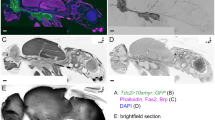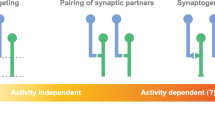Abstract
The sensitivity of specific neuronal pathways to Halothane and N2O has been investigated in flies. The effects were tested by monitoring the responses of photoreceptors and their second order neurons, as well as two behavioral responses-a leg reflex induced by light flashes and head movements induced by moving optical patterns-chosen because their neuronal substrates are fairly well known. Sensitivity to both agents rises with the length of dendrites and the number of input synapses of the neurons involved. The finding confirms the hypothesis, formulated in Part I of this paper, that neurons with long dendrites and/or axonal endings and large numbers of input synapses are the elements in the central nervous system with the highest sensitivity to anesthetic action. Under physiological conditions this kind of neuron is capable of “gain-control”: the relationship between input and output is modified according to functional requirements. Possible molecular mechanisms leading to functional impairment under anesthesia are discussed.
Similar content being viewed by others
References
Alawi AA, Pak WL (1971) On-transient of insect electroretinogram: the cellular origin. Science 172:1055–1057
Björklund A, Lindvall O (1984) Dopamine-containing systems in the CNS. In: Björklund, A, Hökfelt T (eds) Handbook of chemical neuroanatomy, vol 2; Classical transmitters in the CNS, part I. Elsevier, Amsterdam New York, pp 55–122
Delbrück M, Keichardt W (1956) I. System analysis for the light growth reaction of phycomyces. In: Cellular mechanisms in differentiation and growth. Princeton University Press, Princeton
Egelhaaf M (1985) On the neuronal basis of figure-ground discrimination by relative motion in the visual system of the fly. I. Behavioural constraints imposed on the neuronal network and the role of the optomotor system. Biol Cybern 52:123–140
Eger EI (1974) Anesthetic uptake and action. Williams & Wilkins, Baltimore London Los Angeles
Erber J, Kaulen P (1987) Antagonistic action of octopamine and serotonin in the visual system of the honeybee (Apis mellifera L.). 15. Göttinger Neurobiologentagung. In: Elsner N, Creutzfeldt O (eds) New frontiers in brain research. Thieme, Stuttgart New York, p 247
Götz KG (1968) Flight control in Drosophila by visual perception of motion. Kybernetik 4:199–208
Halsey MJ (1980) Physicochemical properties of inhalational anaesthetics. In: Gray TC, Nunn JF, Utting JE (eds) General anaesthesia. 4th edn., vol 1. Butterworths, London Boston Sydney, pp 45–65
Hamdorf K (1979) The physiology of invertebrate visual pigments. In: Autrum H (ed) Handbook of sensory physiology, vol. VII/6A. Springer, Berlin Heidelberg New York, pp 145–224
Hausen K (1982) Motion sensitive interneurons in the optomotor system of the fly. II. The horizontal cells: receptive field organization and response characteristics. Biol Cybern 46:67–79
Hausen K (1984) The lobula-complex of the fly: structure, function, and significance in visual behaviour. In: Ali MA (ed) Photoreception and vision in invertebrates, ser. A: Life sciences, vol 74. Nato ASI Series. Plenum Press, New York London, pp 523–559
Hausen K, Strausfeld NJ (1980) Sexually dimorphic interneuron arrangements in the fly visual system. Proc R Soc Lond B 208:57–71
Hengstenberg R (1982) Common visual response properties of giant vertical cells in the lobula plate of the blowfly Calliphora. J Comp Physiol 149:179–193
Kandel ER, Siegelbaum S (1985) Principles underlying electrical and chemical synaptic transmission. In: Kandel ER, Schwartz JH (eds) Principles of neural science. Elsevier, Amsterdam, pp 89–107
Kirschfeld K, Baier-Rogowski V (1986) Die Neuronale Grundlage des Zustandes der Narkose: ein vergleichendphysiologischer Ansatz. I. Der einfluß von Anaesthetika auf das Verhalten von Insekten. Biol Cybern 55:345–354
Kirschfeld K, Vogt K (1985) The contribution of different colour receptors to a motor output in the fly. J Comp Physiol A 157:417–421
Krnjevic K (1986) In: Roth SH, Miller KW (eds) Molecular and cellular mechanisms of anesthetics. Plenum Press, New York London, pp 3–16
Lillywhite PG, Dvorak DR (1981) Responses to single photons in a fly optomotor neurone. Vision Res 21:279–290
Lux D, Schubert P (1975) unpublished material communicated by P Schubert at neurosciences research program work session on neuron-tarket cell interactions. Boston 22 to 24 June 1975. Zit. in Schmitt FO, Dev P, Smith BH (1976) Electrotonic processing of information by brain cells. Science 193:114–120
Maddess T (1986) Afterimage-like effects in the motions-sensitive neuron H1. Proc R Soc Lond B 228:433–459
Maddess T, Laughlin SB (1985) Adaptation of the motionsensitive neuron H 1 is generated locally and governed by contrast frequency. Proc R Soc Lond B 225:251–275
Milde JJ, Strausfeld NJ (1986) Visuo-motor pathways in arthropods. Naturwissenschaften 73:151–154
Pick B (1976) Visual pattern discrimination as an element of the fly's orientation behaviour. Biol Cybern 23:171–180
Reichardt W, Guo A (1986) Elementary pattern discrimination (behavioural experiments with the fly Musca domestica). Biol Cybern 53:285–306
Reichardt W, Poggio T, Hausen K (1983) Figure-ground discrimination by relative movement in the visual system of the fly. Part II. Towards the neural circuitry. Biol Cybern [Suppl] 46:1–30
Schmitt FO, Dev P, Smith BH (1976) Electrotonic processing of information by brain cells. Science 193:114–120
Siegel JM (1979) Behaviour function of the retinular formation. Brain Res Rev 1:69
Strausfeld NJ, Bacon JP (1983) Multimodal convergence in the central nervous system of insects. In: Horn (ed) Multimodal convergence in sensory systems. Fortschritte Zoologie 28. Fischer, Stuttgart New York
Zaagman W, Masterbroek HAK, van Steveninck RDR (1983) Adaptive strategies in fly vision: on their image-processing qualities. IEEE Trans. SMC-13:900–906
Author information
Authors and Affiliations
Rights and permissions
About this article
Cite this article
Kirschfeld, K., Baier-Rogowski, V. The neuronal basis of the anesthetic state: A comparative physiological approach. Biol. Cybern. 58, 1–11 (1988). https://doi.org/10.1007/BF00363951
Received:
Accepted:
Issue Date:
DOI: https://doi.org/10.1007/BF00363951




